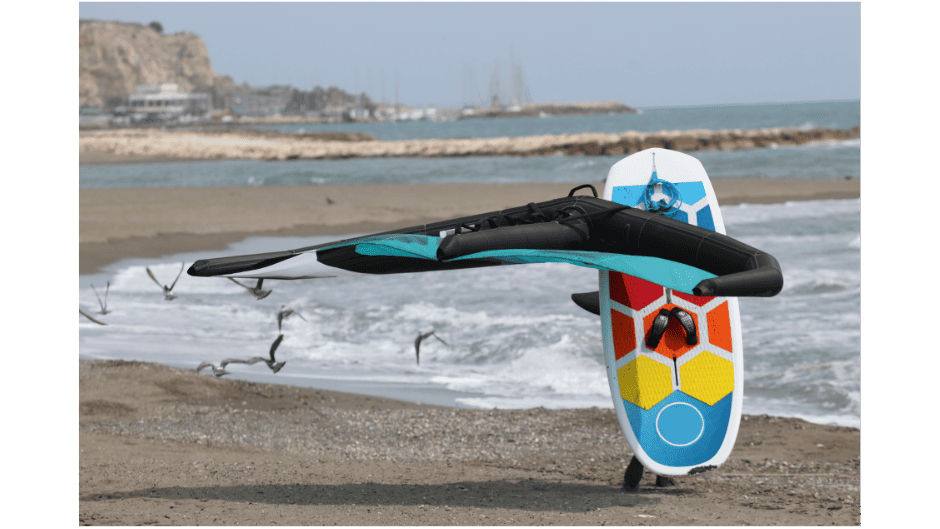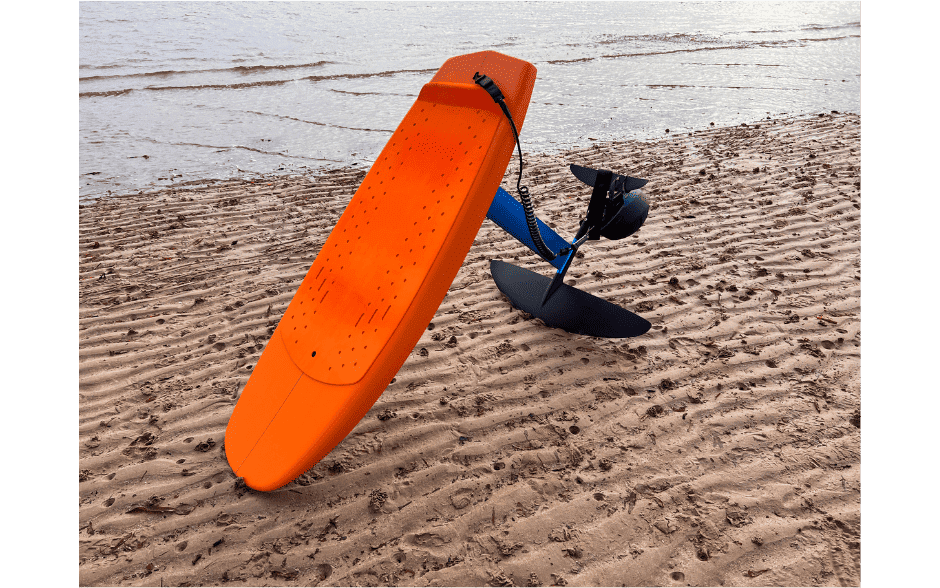What Is Hydrofoil Surfing?

Imagine effortlessly gliding above the water, feeling the thrill of flying while catching waves that were once thought impossible. Welcome to the world of hydrofoil surfing, a cutting-edge water sport that has revolutionized the way we ride the waves.
In this blog post, we’ll dive into the history, science, and techniques behind this exciting sport and discover how it compares to traditional surfing.
Key Takeaways
Hydrofoil surfing is a thrilling water sport that has been around since the early 1900s.
It utilizes aerodynamics and hydrodynamics to generate lift, allowing riders to experience faster speeds and increased efficiency while enjoying the ride.
Hydrofoils offer improved maneuverability, greater distances covered, the unique sensation of flying above the water’s surface & more, but also come with their own set of safety concerns!
The Hydrofoil Revolution: A Brief History

Dating back to the early 1900s, hydrofoil technology was initially developed to enhance the speed of boats without excessive fuel consumption. Fast forward to today, and this unique technology has found its way into various water sports like surfing, kiteboarding, and wakeboarding, all thanks to foil boards, which are specifically designed for these activities.
The foil surfboard, a variant of the foil board, has radically altered the way we ride waves, enabling surfers to accomplish feats previously considered impossible. The latest advancement in hydrofoil technology is electric-powered hydrofoil boards, such as the Lift eFoil. These boards come with an all-electric, silent motor that lets you glide through any body of water, reaching speeds of up to 30 km/h while performing acrobatic maneuvers.
With such innovations, hydrofoil surfing continues to evolve and attract more water sports enthusiasts worldwide, as they glide effortlessly above the water’s surface.
Laird Hamilton and Dave Kalama’s Contributions
Laird Hamilton and Dave Kalama are the biggest names in hydrofoil surfing. These innovators made significant contributions to the development of lift foils, a crucial component of hydrofoil surfboards. Their goal was to achieve faster speeds and smoother rides on big waves, making surf foiling a more enjoyable and thrilling experience.
Laird Hamilton was one of the first to attach a foil to a surfboard, demonstrating its effectiveness in big wave conditions. He showed that hydrofoils could be a fantastic tool in all kinds of swells, as they work by converting the kinetic energy of the water into lift, allowing the surfboard to glide above the surface.
Dave Kalama, on the other hand, played a pivotal role in refining the hydrofoil design and advocating for the sport. Their achievements have been featured in various content and ads, showcasing the benefits of hydrofoil surfing to a wider audience.
Electric-Powered Hydrofoil Boards
The emergence of electric-powered hydrofoil surfboards has revolutionized the sport, enabling riders to reach faster speeds and explore new spots. Comprising of an electric motor, propeller, and carbon fiber foils and mast submerged underwater, these boards also feature a waterproof compartment housing a rechargeable lithium battery and electronic speed controller.
Electric-powered hydrofoil boards have truly changed the game, allowing riders to glide smoothly above the water’s surface, harnessing the power of the electric motor to generate lift. With a variety of boards available, such as the Lift eFoil, Lift Jet, and Lift3 F, riders can easily find the perfect one for their needs and preferences.
The Science Behind Hydrofoils

Hydrofoils harness the principles of aerodynamics and hydrodynamics to produce lift and minimize drag. They are long fins with wings, designed to move through water efficiently. The wings of the hydrofoil are engineered to create lift as they travel through the water, allowing the board to move faster and more efficiently. Additionally, the shape of the wings helps to reduce drag, resulting in the board moving quickly and smoothly.
Understanding the science behind hydrofoils allows us to appreciate their applications in water sports and their advantages over traditional surfboard fins. By generating lift as they move through the water, hydrofoils enable surfers to glide above the surface, reaching higher speeds and experiencing a smoother ride.
Hydrofoil Components
Four primary components constitute a hydrofoil.
Mast: links the bottom of the board to the hydrofoil, keeping it beneath the water’s surface to create lift.
Fuselage: connects the mast to the front and back wings.
Front wing: generates lift and stability.
Back wing: provides stability and controls the direction of the hydrofoil.
These components work together to enable hydrofoil surfing.
The components of a hydrofoil board include:
Front wing: Generates lift as it moves through the water, enabling the board to rise and glide above the surface.
Back wing: Provides stability and maneuverability, ensuring a smooth and controlled ride.
Foot straps or pads: Help riders maintain their balance when picking up speed and performing maneuvers.
These components work together to create an exhilarating and efficient hydrofoil experience.
How Hydrofoils Work
As hydrofoils move forward, they utilize water to generate lift. This lift helps to raise the board off the water, thereby reducing friction. The lifting surface in hydrofoil surfing is the hydrofoil itself, which generates lift by efficiently moving through the water. As the wing tilts upright, it can glide above the surface of the water, allowing the board to move faster and more efficiently.
Hydrofoil technology is particularly popular in racing and high-performance applications due to its ability to boost speed and efficiency. With more speed compared to the lift generated, hydrofoils enable riders to achieve higher speeds and cover greater distances in a shorter time. This increased efficiency makes hydrofoil surfing a thrilling and enjoyable water sport.
Comparing Hydrofoil Surfing to Traditional Surfing

Contrary to traditional surfing where the board is propelled by the push of water, hydrofoil surfing adds a novel dimension to wave riding. By lifting the board above the water’s surface at different speeds, hydrofoil surfing allows riders to tackle waves that seemed impossible before. The unique sensation of flying above the water and the smooth ride offered by hydrofoil surfing make it an exciting alternative to traditional surfing.
Nevertheless, hydrofoil surfing brings with it its unique set of challenges and safety concerns. The wings on hydrofoils have sharp trailing edges, which can pose a risk if not handled carefully. Additionally, bailing off the board can be unpredictable, and wipeouts in bigger waves can be dangerous. Despite these challenges, hydrofoil surfing continues to gain popularity among water sports enthusiasts.
Advantages of Hydrofoil Surfing
Compared to traditional surfing, hydrofoil surfing presents a plethora of advantages, including:
Improved maneuverability
The feeling of flying
The ability to surf even in smaller waves
More efficient at catching waves
Allows riders to cover greater distances
Ability to explore new surf spots without getting stuck in crowded areas
Another advantage of hydrofoil surfing is the wide wind range it offers for wing foiling. With hydrofoils, riders can harness the power of the wind in various conditions, making the sport more versatile and enjoyable.
Overall, hydrofoil surfing provides an exhilarating and unique experience that sets it apart from traditional surfing.
Challenges and Safety Concerns
Mastering hydrofoil surfing can be somewhat challenging, with controlling the hydrofoil and maintaining balance on it in choppy or larger waves proving to be difficult. It also comes with an increased risk of injuries or accidents, so it’s important to practice and build up your skills before venturing into more challenging conditions. Being aware of your surroundings and the other people in the water is crucial for ensuring a safe and enjoyable experience.
Wearing a life jacket and helmet is a good idea for added protection, especially when learning to hydrofoil surf. As you gain experience and confidence, you can gradually progress to more challenging waves and conditions, while always keeping safety in mind.
Choosing the Right Hydrofoil Board

Choosing an optimal hydrofoil board that suits your needs and preferences is vital for a rewarding and enjoyable hydrofoil surfing experience. Hydrofoil boards come in various designs, tailored to different skill levels and riding styles. Additionally, the materials used in hydrofoil board construction play a significant role in the board’s performance and durability.
Whether you’re a beginner or an experienced rider, understanding the different types of hydrofoil boards and their materials will help you make an informed decision when choosing the right board for you.
Types of Hydrofoil Boards
A variety of hydrofoil board designs cater to different skill levels and riding styles, including:
Kiteboarding hydrofoils
Foilboards
Surfing hydrofoils
Foil surfboards
SUP hydrofoils
SUP foilboards
Wakefoils
Wakefoil boards
Each type of hydrofoil board is designed to cater to specific types of riding, offering different levels of speed, stability, and control.
For example, different types of hydrofoils are designed for specific water sports.
Kiteboarding hydrofoils prioritize speed and maneuverability
Surfing hydrofoils focus on providing maximum stability and control
SUP hydrofoils strike a balance between speed and stability, making them suitable for stand-up paddleboarding enthusiasts
Wakefoils are perfect for wakeboarding and wake surfing, offering a unique and thrilling ride.
Carbon Fiber vs. Fiberglass
Carbon fiber and fiberglass are the two most common materials used in hydrofoil board construction. Carbon fiber hydrofoils are lighter and more durable, but they come with a higher price tag. In contrast, fiberglass hydrofoils are more affordable and easier to repair, but they are heavier and not as long-lasting.
When choosing between carbon fiber and fiberglass hydrofoil boards, consider factors such as your budget, skill level, and personal preferences. While carbon fiber boards offer a livelier feel and greater durability, fiberglass boards may be more suitable for beginners or those on a tighter budget.
Learning to Hydrofoil Surf: Tips for Beginners

For newcomers to hydrofoil surfing, starting with the basics to establish a solid foundation in the sport is crucial. Learning to hydrofoil surf can be challenging, but with the right guidance and practice, it can be an incredibly rewarding and enjoyable experience.
Begin by familiarizing yourself with the different components of a hydrofoil board and understanding how they work together to create lift and movement. Once you have a grasp of the basic principles, you can move on to mastering essential skills such as the pop up and ride, as well as finding the ideal surf spot for your skill level and preferences.
Finding the Ideal Surf Spot
Identifying a safe and appropriate location for practicing hydrofoil surfing is critical to ensure both safety and enjoyment. If you’re just starting out or don’t feel confident in your skills, it’s best to find a spot with no one else around. This will allow you to practice and build your skills without worrying about the safety of others or feeling self-conscious.
When searching for the perfect surf spot for regular surfing, consider factors such as wave size, wind conditions, and other water users. Starting with one-to-two-foot waves is ideal for beginners, as larger waves can be more challenging and dangerous. As you gain experience and confidence, you can gradually progress to more challenging conditions and explore new surf spots.
Mastering the Pop Up and Ride
Refining the essential skills required for successful hydrofoil surfing is vital for a seamless and enjoyable ride. The pop-up and ride is the first step in getting on a wave and succeeding in the sport. To master this skill, start by practicing on flat water, putting pressure on your front foot, and leaning forward as the wave gets steeper.
Popping up quickly and smoothly is essential for maintaining balance and control while hydrofoil surfing. As you practice and build your skills, you’ll become more comfortable with the unique sensation of flying above the water and the thrill of riding waves that were once thought impossible.
Foil Surfing Beyond the Waves: Other Applications

The application of hydrofoil technology extends beyond surfing; it’s incorporated into other water sports like kiteboarding and windsurfing, enhancing speed and efficiency in these activities too. Pioneers like Kai Lenny have tested hydrofoils in various water sports, including windsurfing, kiteboarding, surfing, and even bodyboarding.
The versatility of hydrofoil technology enables its use in:
Commercial transportation
Hydrofoil-supported vessels
Yachts
Foil boards
Superyachts
Racing boats
Ferries
With its many applications, hydrofoil technology continues to transform the world of water sports and beyond.
Kiteboarding with Hydrofoils

Kiteboarding with hydrofoils offers a unique and thrilling experience, providing riders with increased speed and smoother rides compared to traditional kiteboarding. The use of hydrofoil boards in kiteboarding was initiated by Mango Carafino and has since grown in popularity, leading to the development of Hydrofoil Kite Board Racing.
Incorporating hydrofoils into kiteboarding allows riders to harness the power of the wind more efficiently, resulting in faster speeds and greater maneuverability. This combination of speed and control makes hydrofoil kiteboarding an exciting and challenging water sport for those looking to push their limits.
Windsurfing on Hydrofoils
Windsurfing on hydrofoils offers a range of benefits, including higher speeds, greater efficiency, and the ability to perform in a variety of conditions, from flat water to choppy waves. However, incorporating hydrofoils into windsurfing also presents its own set of challenges and safety concerns.
Mastering windsurfing on hydrofoils requires practice and skill, as controlling the hydrofoil and maintaining balance can be tricky. Additionally, the increased speed and potential for the board to slam into the water at high velocity pose risks to the rider.
Despite these challenges, windsurfing on hydrofoils continues to gain popularity among water sports enthusiasts looking for a new and exhilarating experience, similar to the thrill of riding a jet ski.
Summary
Hydrofoil surfing has transformed the world of water sports, offering a unique and thrilling experience that sets it apart from traditional surfing. With its roots in early 20th-century technology, hydrofoil surfing has evolved into a cutting-edge sport thanks to pioneers like Laird Hamilton and Dave Kalama, as well as innovations like electric-powered hydrofoil boards. The science behind hydrofoils, the techniques for mastering this sport, and its applications in other water sports such as kiteboarding and windsurfing, make hydrofoil surfing an exciting and versatile pursuit. So, are you ready to take flight and ride the waves like never before?
Frequently Asked Questions
What is the point of hydrofoil?
Hydrofoils are structures with a wing-like shape that generate lift by pushing the boat’s hull out of the water. This reduces drag and increases acceleration, resulting in greater speeds and more power with less strain on the engine.
Hydrofoils provide a great ride even with only a modest increase in speed.
Why don’t more boats use hydrofoil?
Hydrofoils are expensive to build, about 3 times the cost of a standard boat. Furthermore, they are mainly used for high-speed passenger ferries, as passenger fees offset the craft’s costs.
As such, hydrofoils are not widely available or accessible for most boat owners.
Does a hydrofoil slow a boat down?
Hydrofoils help reduce drag and increase speed, so they don’t slow down a boat.
How do hydrofoil boats float?
Hydrofoil boats are lifted out of the water as they increase their speed due to hydrofoils attached to the hull and the hydrodynamic lift generated by these foils. This reduces wave resistance and drag, allowing the boat to float on a cushion of air.
Is foil surfing harder than surfing?
Foil surfing requires a lot of balance and coordination, which makes it harder than traditional surfing.
Therefore, it’s best to hone your skills on a regular surfboard before taking on foil surfing.





